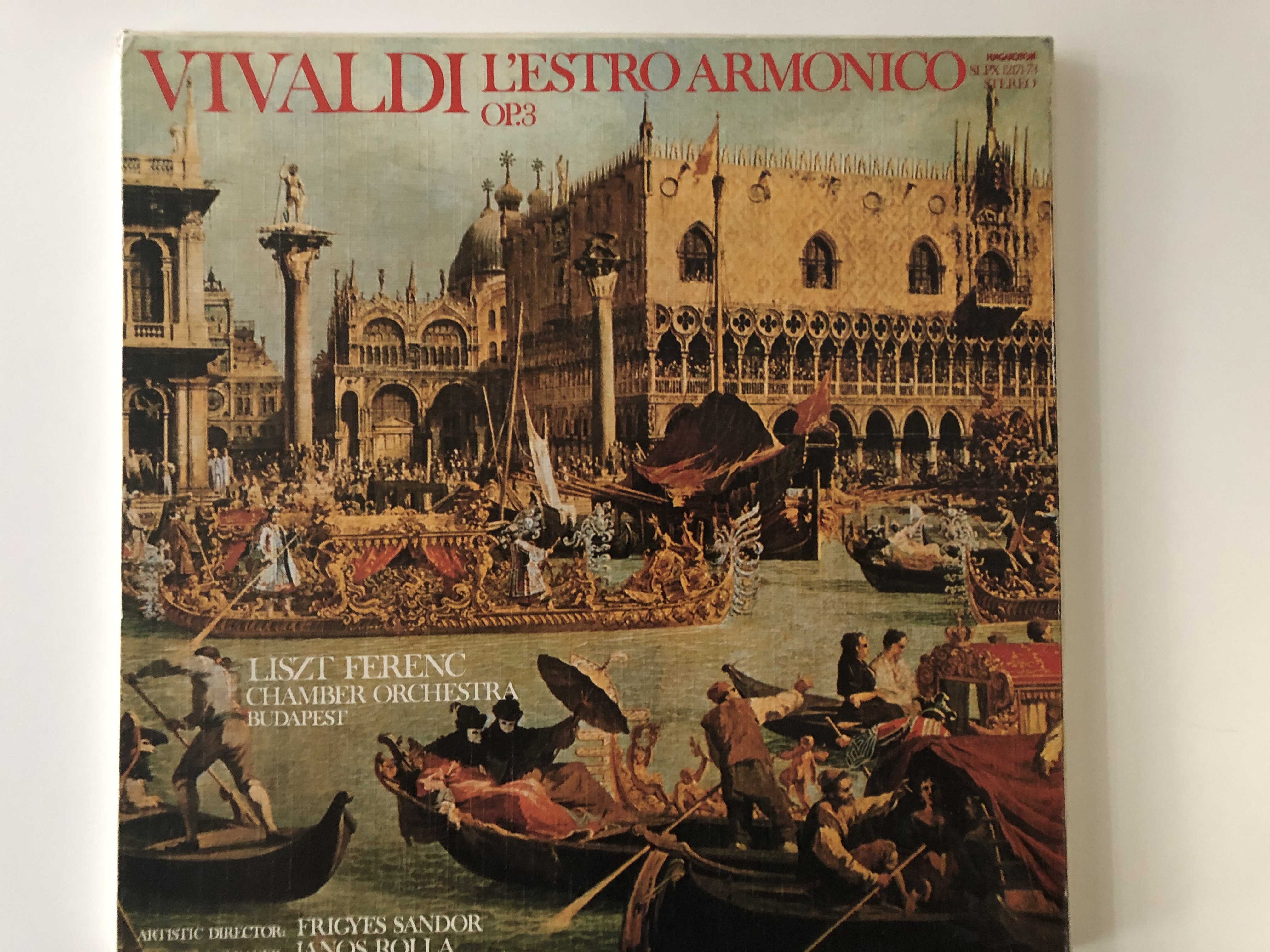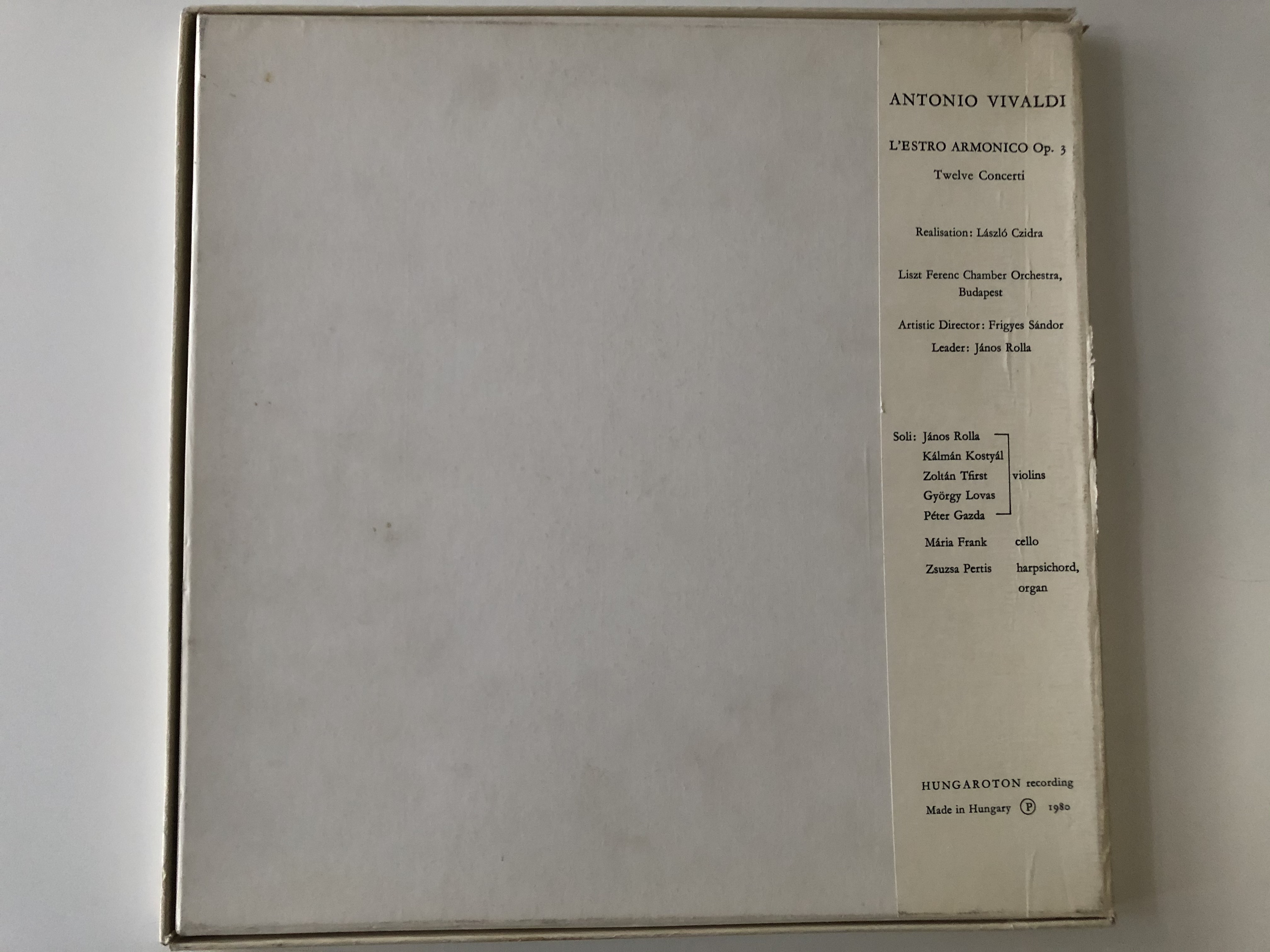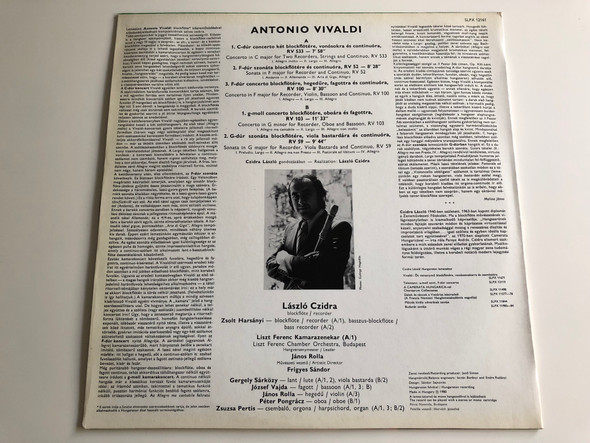Description
Vivaldi - L'Estro Armonico Op. 3 / Liszt Ferenc Chamber Orchestra, Budapest / Artistic director: Frigyes Sándor, János Rolla / Hungaroton 3x LP 1980 Stereo
SLPX 12171-73
L'estro armonico (The Harmonic Inspiration), Op. 3, is a set of 12 concertos for stringed instruments by Italian composer Antonio Vivaldi, first published in Amsterdam in 1711. Vivaldi's Twelve Trio Sonatas, Op. 1, and Twelve Violin Sonatas, Op. 2, only contained sonatas, thus L'estro armonico was his first collection of concertos appearing in print. It was also the first time he chose a foreign publisher, Estienne Roger, instead of an Italian. Each concerto was printed in eight parts: four violins, two violas, cello and continuo. The continuo part was printed as a figured bass for violone and harpsichord.
The concertos belong to the concerto a 7 format, that is: for each concerto there are seven independent parts. In each consecutive group of three concertos, the first is a concerto for four violins, the second for two violins, and the third a solo violin concerto. The cello gets solistic passages in several of the concertos for four and two violins, so that a few of the concertos conform to the traditional Roman concerto grosso format where a concertino of two violins and cello plays in contrast to a string orchestra. L'estro armonico pioneered orchestral unisono in concerto movements.
Vivaldi composed a few concertos specifically for L'estro armonico, while other concertos of the set had been composed at an earlier date. Vivaldi scholar Michael Talbot described the set as "perhaps the most influential collection of instrumental music to appear during the whole of the eighteenth century".
Tracklist:
| Concerto No. 1 D Major RV 549 | (8:52) | ||
| A1 | I. Allegro | ||
| A2 | II. Largo E Spiccato | ||
| A3 | III. Allegro | ||
|
Concerto No. 2 G Minor RV 578 |
(10:30) |
||
| A4 | I. Adagio E Spiccato | ||
| A5 | II. Allegro | ||
| A6 | III. Larghetto | ||
| A7 | IV. Allegro | ||
|
Concerto No. 3 G Major RV 310 |
(7:40) |
||
| B1 | I. Allegro | ||
| B2 | II. Largo | ||
| B3 | III. Allegro | ||
|
Concerto No.4 E Minor RV 550 |
(7:43) |
||
| B4 | I. Andante | ||
| B5 | II. Allegro Assai | ||
| B6 | III. Adagio | ||
| B7 | IV. Allegro | ||
|
Concerto No. 5 A Major RV 519 |
(7:35) |
||
| C1 | I. Allegro | ||
| C2 | II. Largo | ||
| C3 | III. Allegro | ||
|
Concerto No. 6 A Minor RV 356 |
(8:10) |
||
| C4 | I. Allegro | ||
| C5 | II. Largo | ||
| C6 | III. Presto | ||
|
Concerto No. 7 F Major RV 567 |
(10:20) |
||
| D1 | I. Andante | ||
| D2 | II. Adagio | ||
| D3 | III. Allegro | ||
| D4 | IV. Adagio | ||
| D5 | V. Allegro | ||
|
Concerto No. 8 A Minor RV 522 |
(11:43) |
||
| D6 | I. Allegro | ||
| D7 | II. Larghetto E Spiritoso | ||
| D8 | III. Allegro | ||
|
Concerto No. 9 D Major RV 230 |
(8:34) |
||
| E1 | I. Allegro | ||
| E2 | II. Larghetto | ||
| E3 | III. Allegro | ||
|
Concerto No. 10 B Minor RV 580 |
(9:52) |
||
| E4 | I. Allegro | ||
| E5 | II. Largo | ||
| E6 | III. Larghetto | ||
| E7 | IV. Allegro | ||
|
Concerto No. 11 D Major RV 565 |
(10:47) |
||
| F1 | I. Allegro | ||
| F2 | II. Adagio E Spiccato. Allegro | ||
| F3 | III. Largo E Spiccato | ||
| F4 | IV. Allegro | ||
|
Concerto No. 12 E Minor RV 265 |
(11:18) |
||
| F5 | I. Allegro | ||
| F6 | II. Largo | ||
| F7 | III. Allegro |
- Cello, Soloist – Mária Frank
- Composed By – Antonio Vivaldi
- Conductor – Frigyes Sándor
- Engineer [Balance Engineer] – Endre Radányi, István Berényi
- Graphic Design – Péter Nagy (3)
- Harpsichord, Organ, Soloist – Zsuzsa Pertis
- Leader – János Rolla
- Liner Notes – János Malina
- Orchestra – Liszt Ferenc Chamber Orchestra
- Producer – Jenő Simon
- Violin – György Lovas (tracks: A1 to A3, B4 to B7, D1 to D5, E4 to F4)
- Violin, Soloist – János Rolla (tracks: A1 to A7, B4 to C3, D1 to F4), Kálmán Kostyál (tracks: A1 to A3, B1 to B7, D1 to D8, E4 to7), Péter Gazda (tracks: C1 to C3), Zoltán Tfirst (tracks: A1 to A7, B4 to B7, C4 to D5, E4 to E7)


Box 40

























